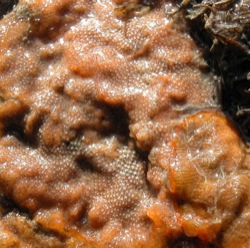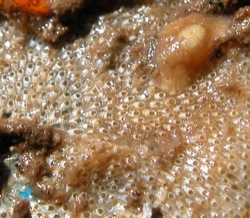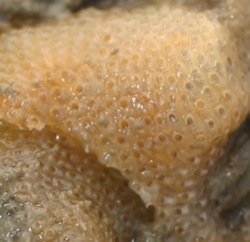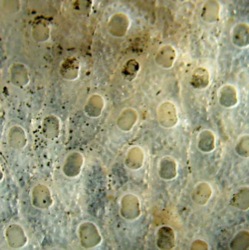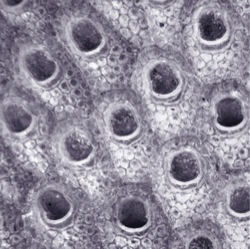Cryptosula pallasiana (Moll, 1803)
- Kingdom: Animalia
- Phylum: Bryozoa
- Class: Gymnolaemata
- Order: Cheilostomata
- Suborder: Ascophora
- Family: Cryptosulidae
Cryptosula pallasiana is a colonial animal that grows in flat, encrusting sheets on a variety of substrates including shells, rocks, wood, glass, plastic, cement, seaweeds, sea grasses and solitary sea squirts. On flat surfaces the colonies may be more or less round and several centimeters across. In Florida, the edges of some colonies are raised in frills.
The individuals within a Cryptosula pallasiana colony are called zooids. A zooid's soft tissues are called the polypide, which lies on its back in a rigid, rectangular or coffin-shaped box, called the zooecium (Greek for "animal house"). Each zooecium is 0.4-0.5 mm wide and 0.6-1.0 mm long, and they are packed side-by-side and end-to-end in the colony, radiating outward from the initial "founding" zooid. The "foot" end of a zooecium generally points toward the center of the colony, and the head end toward the colony's outer edge. The overall color of the colony is white, orange or pink. Orange, pink or yellow embryos are sometimes visible within the zooecia .
Some of the following details can be seen with a hand lens; others require a microscope. Cryptosula pallasiana feeds with a crown of tentacles, called a lophophore, that surrounds the mouth on the head end of the polypide. The tentacles have rows of cilia arrayed along their inner faces and sides. To feed, the lophophore and upper end of the polypide are pushed out of the zooecium through an opening called the aperture, which is on the zooecium's upper surface near its head end. The tentacles are held stiffly, forming a sort of cone-shaped funnel with the mouth at the bottom. Currents produced by the beating of the cilia carry food particles (primarily microscopic plankton) down along the tentacles to the mouth.
In Cryptosula pallasiana, the aperture is in the shape of a round-cornered square or squat rectangle that is pinched in a little on the lower part of the sides. It has been described by different authors as bell-shaped, horseshoe-shaped or keyhole-shaped. The upper surface of the zooecium is covered by large pores, both below and above the aperture. The zooecium's upper surface is sometimes raised into a small bump or hill just below the aperture. Cryptosula pallasiana has no spines, no avicularia (structures with a jaw-like element that opens and closes) and no ovicells (specialized structures for brooding embryos)—elements that are conspicuous features in many bryozoans.
Cryptosula pallasiana is eaten by various nudibranchs, sea urchins and fish.
Similar Species
Cryptosula pallasiana's relatively large, bell-shaped aperture, and the large pores on its upper surface occurring above as well as below the aperture, distinguish it from all other encrusting bryozoans on the Pacific Coast.
Native Range
Native to the Atlantic, where it has been reported from Norway and Great Britain to Morocco, in the Mediterranean and Black Seas, and from Nova Scotia to Florida, though Carlton and Ruckelshaus (1996) list it as introduced to Florida.
Introduction and Distribution on the Pacific Coast [with dates of first record]
- British Columbia: east side of Vancouver Island and Strait of Georgia [reported in 1970]
- Washington: Puget Sound
- Oregon: Coos Bay [collected in 1988]
- California: Humboldt Bay [collected in 2000-01], Fort Bragg [collected in 2000], Bodega Harbor [reported in 1975], Tomales Bay [collected in 2001], San Francisco Bay [collected in 1944-47], Elkhorn Slough [collected in 1998], Monterey Bay [reported in 1952], Morro Bay [collected in 2000], Santa Barbara [collected in 2001], Channel Islands Harbor [collected in 2000], Port Hueneme [collected in 2000], Marina del Rey [collected in 1964], King Harbor [reported in 1972], Los Angeles/Long Beach harbors [collected in 1965], Alamitos Bay [collected in 1962], Newport Bay [collected in 1943-44], Oceanside Harbor [collected in 2001], La Jolla [reported in 1952], Mission Bay [1997], San Diego Bay [collected in 2001]
In Puget Sound, Cryptosula pallasiana has been collected from several sites in southern Puget Sound and at Blaine near the Canadian border. In San Francisco Bay it occurs from the mouth of the bay north to San Rafael and Point San Pablo and south to Redwood Creek and San Leandro.
Cryptosula pallasiana was first reported on the Pacific Coast in the mid-1940s in Newport Bay and San Francisco Bay. It was likely introduced either as hull fouling or with shipments of Atlantic oysters, with which it occurs on the Atlantic coast. Since its larvae spend a very short time in the plankton, it is a poor candidate for inter-oceanic transport by ballast water.
Additional Global Distribution [with dates of first record]
Hawaii [reported in 1968]; Japan [reported in 1963]; New Zealand [reported on ships in 1960, and on non-transient substrate in 1967] and Australia including South Australia [reported in 1977], Victoria [in Port Phillip Bay in the late 1800s], New South Wales and northern Queensland; Argentina [reported in 1965] and Chile
As discussed above, Cryptosula pallasiana has primarily been moved about either as hull fouling or, in some cases, possibly with transfers of oysters or other shellfish.
Other names that have been used in the scientific literature
Eschara pallasiana, Lepralia pallasiana, Smittina pallasiana
Literature Sources and Additional Information
Carlton, J.T. 1979. History, Biogeography, and Ecology of the Introduced Marine and Estuarine Invertebrates of the Pacific Coast of North America. Ph.D. thesis, University of California, Davis, CA (pp. 720-722).
Carlton, J.T. and M.H. Ruckelshaus. 1996. Non-indigenous marine invertebrates and algae. Page 187-201 in: Simberloff, D., D.C. Schmitz and T.C. Brown (eds.), Strangers in Paradise: Impact and Management of Nonindigenous Species in Florida. Island Press, Washington, DC.
Cohen, A.N. and J.T. Carlton. 1995. Nonindigenous Aquatic Species in a United States Estuary: A Case Study of the Biological Invasions of the San Francisco Bay and Delta. U.S. Fish and Wildlife Service, Washington, DC (p. 108).
Websites
CSIRO Centre for Research on Introduced Marine Pests (CRIMP) - National
Introduced Marine Pest Information System (NIMPIS)
http://www.marine.csiro.au/crimp/nimpis/spSummary.asp?txa=6941
Smithsonian Marine Station at Fort Pierce - Indian River Lagoon Species
Inventory
http://www.sms.si.edu/irlspec/Crypto_pallas.htm

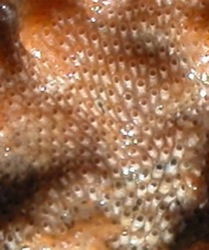 Cryptosula pallasiana
Cryptosula pallasiana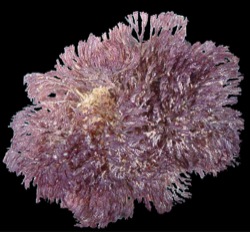 Bugula neritina
Bugula neritina 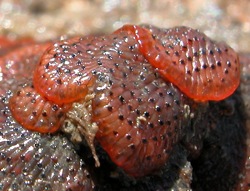 Watersipora subtorquata
Watersipora subtorquata